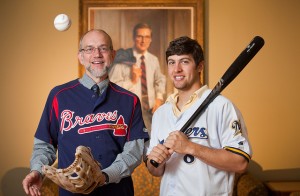Sports fans should sit down for this one. Athletes are not overpaid, says Thomas Bruggink, but on average are paid what they contribute to team revenues. Revelations like that wouldn’t really be revelations if the casual observer applied some economic theories to sport.

Professor Thomas Bruggink and Brian Davila ’12
Economists can put many theories to the test by applying them to athletics, which is why much of Bruggink’s research focuses on the economics of sports, particularly baseball. In fact, moviegoers who enjoyed Moneyball, starring Brad Pitt as the general manager of the Oakland A’s who used computer-generated analysis to put together a team on a budget, were watching an example of how economics influence baseball. Bruggink published an article, co-authored with Anthony Farrar ’07, “A New Test of the Moneyball Hypothesis,” in The Sport Journal the year the movie was released.
“Sports offer a great laboratory to test economic theory,” explains Bruggink, professor of economics. “Individual player productivity is easily measured, and the linkage to team winning is strong. Demand theory, production functions, total cost functions, present value of assets, economic spillovers, public subsidies, salary determination, labor relations, and monopoly pricing all have counterparts in sports. With the data in hand, we can actually verify that players, on average, are paid what they are worth in terms of how they add to team victories, and how those victories are tied to team revenue. You cannot do this on such a micro level in the business world.”
Subsidized stadiums are a great example, says Bruggink. Public subsidies do not give a very good return on the government investment as they don’t produce any net creation of jobs in the city. Spending on sports activities by fans is simply rearranged, not new, spending. In the absence of the sports team, fans would just spend more money on alternative entertainment options.
What does justify subsides is the sense of civic pride and community that having a sports team provides. Strangers who are stalwart Yankees fans or resigned Cubs fans have at least one thing in common: their loyalty to the home team.
During a recent sabbatical leave, Bruggink put the finishing touches on three professional papers, all of which will be submitted for publication. He often involves students as research assistants, and has published 10 articles with Lafayette students as co-authors.
“Working with students forces me to educate myself in the student’s topic,” he says. “I become more knowledgeable as a result. When the project turns out well, it is rewarding to be part of it.”
Bruggink presented research on how the desegregation of baseball affected the playing style and team winning function this summer at the Third International Conference on Sport and Society at Cambridge University. His study found that it was the addition of African American power hitters to the National League that made the most difference, not those with base-running prowess, as was previously thought. Today, teams can recruit players from the Dominican Republic, Venezuela, Japan, and Korea at a much lower cost, which is comparable to the standard industrial practice of looking to foreign markets for a cheaper way to do business.
Bruggink also presented his study on University of Michigan sport management professor Rodney Fort’s production function (output for all combinations of inputs) in the popular textbook Sports Economics at the Western Economic Association in San Francisco this summer. Brian Davila ’12 assisted Bruggink with his work. Bruggink found that there is empirical support for the general shape of Fort’s baseball production function, but the key issue is whether the rate of increase rises at first before falling. The textbook graph shows that the rate of increase starts to decline with the addition of the seventh star player, but Bruggink’s results show the rate of increase declines starting with the fourth star player, and the increases fall sharply thereafter.
Last March, Bruggink presented the results of his research into whether appearance and award bonuses in major league baseball contracts affect performance at the Eastern Economic Association in Boston. John Stewart ’10 was a coauthor of the research. Team owners commonly include bonus clauses in their contracts with baseball players; however, by baseball rules, the bonuses are not tied to statistical performances but rather to awards and game appearances. Bruggink found modest improvements in the number of at-bats, batting average, and slugging average for hitters who have bonus clause contracts over a wide range of bonus values.
Currently, Bruggink is advising an honors thesis by economics major Christopher Lake ’13 (Wynnewood, Pa.) on selection bias in the NCAA basketball tournament.

2 Comments
Professor Bruggink’s courses at Lafayette College were always among my favorite. I am happy to hear that he is still proving that economics is such a fascinating field.
Really interesting article, Tom. I am so impressed!!
Joan
Comments are closed.